By Paul Roggemans and Peter Cambell-Burns
Japanese observers reported the discovery of a new minor shower listed as alpha Aquariids (927-AAQ) in the IAU Working list of meteor showers. A search in the orbit catalogues of the largest video camera networks resulted in a large number of similar orbits, with a significant number of orbits which fulfill the high threshold D-criteria. This analysis fails to find indications for the presence of a concentration of orbits that prove the existence of the alpha Aquariid meteor shower. The distribution of the orbits in time and space indicates the presence of a large number of similar but random distributed unrelated sporadic orbits in the ecliptic. Taking the physical properties into account (exceptional high beginning heights), no indication for any orbit concentration could be found. The shower discovery may be explained as a coincidence of unrelated sporadic orbits, unless other networks could produce evidence for the occurrence of similar orbits in 2017 with the same unusual beginning heights and ablation display as “melting meteors”.
1 Introduction
In the night of 26 October 2017 the Japanese SonotaCo meteor network captured some meteors with a remarkable slow speed and similar luminosity profile (http://sonotaco.jp/forum/viewtopic.php?t=3977). Chikara Shimodo noticed a remarkable luminosity profile for a fireball, captured by 11 cameras at 9 stations of the SonotaCo network in Japan on 26 October 2017 at 14h51m48s UT. The orbital elements for this fireball were computed as:
- λʘ = 213.1417°
- α = 328.2 ± 0.2°
- δ = 1.8 ± 0.2°
- vg = 7.95 ± 0.02 km/s
- a = 2.156 ± 0.009 AU
- q =0.9768 ± 0.0003 AU
- e = 0.546 ± 0.002
- ω = 198.0 ±0.2 °
- Ω = 213.1369 ± 0.0001°
- i = 2.94 ± 0.04°
Independent from this event Yasuo Shiba noticed a concentration of 4 meteors with similar radiants and velocities, including the fireball mentioned above. The data for these 4 meteors is listed in Table 1.
No known meteor shower could be associated with these radiant positions or with this orbit. In the period of 23 October until 1 November the SonotaCo network collected 812 orbits among which the above 4 mentioned meteors with a characteristic light curve and very slow velocity. The other nights were checked but there have been two typhoons over Japan in October 2017 leaving only few observable nights.
On the 1st of November 2017 Yasuo Shiba (SonotaCo Network) concluded that these meteors could indicate a new unknown minor meteor shower with a radiant at the border of Aquarius and Pegasus. The new minor shower was reported to the IAU and a paper was sent to IMO for publication (Shiba et al., 2018). Based on the announcement of the publication about the new shower the discovery was included in the IAU Meteor Shower List with the identification AAQ (alpha Aquariids) and IAU number 927.
Table 1 – The four meteors on which the discovery of the AAQ-927 was based.
| Date (UT) | λʘ (°) | α (°) | δ (°) | vg (km/s) |
| 2017.10.26 12h09m04s | 213.029 | 331.5±6.3 | +0.2±9.0 | 7.5±4.3 |
| 2017.10.26 14h51m48s | 213.142 | 328.2±0.2 | +1.8±0.2 | 7.95±0.02 |
| 2017.10.26 15h13m18s | 213.157 | 324.7±1.6 | +0.1±0.7 | 8.1±0.4 |
| 2017.10.27 10h54m07s | 213.975 | 329.3±0.7 | -8.1±11.4 | 7.4±3.7 |
All CAMS networks of the global CAMS project had collected 1184 orbits for 26 October, 66 of which were collected by the CAMS BeNeLux network. 1186 orbits were collected for 27 October, of which 166 orbits were registered by CAMS BeNeLux. In spite of the large numbers of orbits registered, no triggers went off to indicate any possible new meteor shower.
With the radiant position being near the ecliptic plane the newly announced meteor shower is embedded in a region that is very rich in sporadic meteoroids. The very slow velocity for meteors from any shower in this area close to the antapex causes a very large dispersion on the radiant size. Since the 2017 CAMS data fails to confirm any outburst, the authors searched all public available orbit data in an attempt to find more details for the alpha Aquariids (AAQ-927) meteor shower.
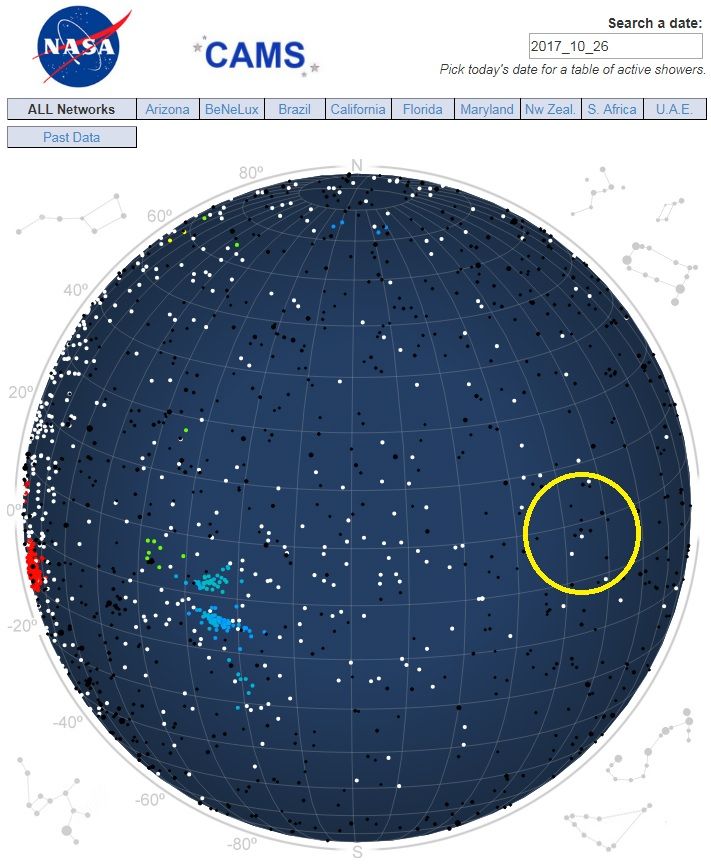
Figure 1 – The radiant map for the night of 26 October for all CAMS networks (1184 orbits). The position of the AAQ-927 radiant is marked with a yellow circle.
2 The available orbit data
We have the following data, status as until April 2018, available for our search:
- EDMOND EU+world with 317830 orbits (until 2016). EDMOND collects data from different European networks which altogether operate 311 cameras (Kornos et al., 2014).
- SonotaCo with 257010 orbits (2007–2017). SonotaCo is an amateur video network with over 100 cameras in Japan (SonotaCo, 2009).
- CAMS with 111233 orbits (October 2010 – March 2013), (Jenniskens et al., 2011). For clarity, the CAMS orbits April 2013 – April 2018 are not included in this dataset because this data is still under embargo.
Altogether we can search among 686073 video meteor orbits.
3 Preliminary orbit selection
The authors followed the procedure described in a previous similar analysis (Roggemans and Johannink, 2018) to identify possible AAQ orbits. Based on the known radiant position, velocity and date of activity, we can define a sub-dataset to limit the amount of orbits in time and space to a region where related orbits might be located.
In a first attempt orbits were selected in a period of 10 days before and after 26 October. All orbits within the following intervals were selected:
- Time interval: 203° < λʘ < 223°;
- Radiant area: 309° < α < 338° and –8° < δ < +12°;
- Velocity: 4 km/s < vg < 12 km/s.
In total 75 orbits occurred within these intervals, 33 from SonotaCo, 23 from EDMOND and 19 from CAMS data. These 75 orbits were obtained from meteors that appeared in the sky in a way that any single station observer would associate these meteors as AAQ shower members, coming from the right direction of the radiant with the right angular velocity expected for this shower. The purpose of analyzing the orbital data is to get an idea how many of these orbits are nothing else than sporadics that contaminate the radiant area and how many of these orbits have enough similarity to form a concentration that indicates the presence of a minor shower.
The median values for these 75 orbits compare very well with the orbital parameters given by Yasuo Shiba. The error margins σ represents the standard deviation:
- λʘ = 211.5°
- α = 328.1 ± 6.7°
- δ = 2.0 ± 5.4°
- vg = 8.1 ± 1.3 km/s
- a = 2.17 ± 0.63 AU
- q =0.9745 ± 0.01 AU
- e = 0.550 ± 0.09
- ω = 199.1 ± 5.9 °
- Ω = 211.53 ± 5.5°
- i = 2.91 ± 1.3°
61 of the 75 orbits fulfill the D criteria (DSH < 0.25 & DD < 0.105 & DH < 0.25) using the median values listed above as parent orbit, 33 orbits fulfill the D criteria with the highest threshold (DSH < 0.1 & DD < 0.04 & DH < 0.1).
This looks very promising for the presence of some meteor stream in this sample. Browsing the individual orbits in the sample, perfectly matching orbits appear at both limits of our selection, right after λʘ = 203° and right before λʘ = 223°. This would indicate that more potential shower members are present beyond the time interval that we selected. Therefore a new, broader selection was made to resume the shower search procedure.
4 Final orbit selection
A new selection was made for a dataset of orbits within the following intervals:
- Time interval: 198° < λʘ < 228°;
- Radiant area: 300° < α < 359° and –12° < δ < +16°;
- Velocity: 4 km/s < vg < 15 km/s;
- Ecliptic latitude north of ecliptic β > 0°.
The time interval now covers 30 days, to compensate for the radiant drift and the typical large spread on any radiant for low velocity showers the radiant area was taken wider. This selection included orbits south of the ecliptic while we search a meteor shower north of the ecliptic, therefore orbits with an ecliptic latitude β south of the ecliptic were rejected. The final sample contains 346 orbits, 133 from SonotaCo, 139 from EDMOND and 74 from CAMS.
We apply three discrimination criteria to evaluate the similarity between the individual orbits taking the median values of the 346 selected orbits as parent orbit. The D-criteria used are these of Southworth and Hawkins (1963), Drummond (1981) and Jopek (1993). We consider four different threshold levels of similarity:
- Low: DSH < 0.25 & DD < 0.105 & DH < 0.25;
- Medium low: DSH < 0.2 & DD < 0.08 & DH < 0.2;
- Medium high: DSH < 0.15 & DD < 0.06 & DH < 0.15;
- High: DSH < 0.1 & DD < 0.04 & DH < 0.1.
240 orbits fulfill the low threshold D-criteria with the median values of our 346 orbits as parent orbit. If our dataset contains a concentration of orbits of the AAQ shower, the median values should be comparable. The results are shown in Table 2 and compare very well with the reference orbit.
Table 2 – The median values for the selected orbits with four different threshold levels on the D-criteria, compared to the reference orbit from literature (Shiba et al., 2018).
| Low | Medium low | Medium high | High | Reference (2018) | |
| λʘ | 209.7° | 209.7° | 209.3° | 210.3° | 213.1° |
| αg | 338.7° | 336.2° | 335.3° | 335.3° | 328.2° |
| δg | +4.4° | +3.7° | +3.8° | +2.6° | +1.8 |
| vg | 9.3 | 9.0 | 9.1 | 9.0 | 8.0 |
| a | 2.29 | 2.29 | 2.31 | 2.30 | 2.16 |
| q | 0.957 | 0.961 | 0.962 | 0.963 | 0.977 |
| e | 0.587 | 0.582 | 0.585 | 0.582 | 0.546 |
| ω | 205.6° | 204.1° | 203.9° | 204.0° | 198.0° |
| Ω | 209.7° | 209.7° | 209.3° | 210.3° | 213.1 |
| i | 3.0° | 3.0° | 3.2° | 2.9° | 2.9° |
| N | 240 | 177 | 116 | 54 | 1 (4) |
| S | 31% | 49% | 66% | 84% |
In Table 2 we select those orbits that fit the low threshold D-criteria to eliminate the obvious sporadic contamination from the sample. Table 2 shows the percentage (S) of orbits of the sample that fails to fulfill the D-criteria and must be considered as sporadic contamination of the radiant area. The remainder is an indication for the possible presence of a dust concentration within the sample.
In the next step we take the median values for the orbits that fulfill the high threshold D-criteria (DSH < 0.1 & DD < 0.04 & DH < 0.1) from Table 2 as parent orbit to recalculate the D-criteria for all 346 orbits of the dataset. The results are listed in Table 3. The median values for all orbits for each level of threshold on the D-criteria compare very well with the reference orbit given by Shiba et al. 11 orbits fulfill the very high threshold of DD < 0.02 representing very similar orbits. So far, we have strong indications for the presence of a meteor shower at this position in the solar system.
Table 3 – The median values for the selected orbits with four different threshold levels on the D-criteria, using the high threshold orbit from Table 2 as parent orbit, compared to the reference orbit from literature (Shiba et al., 2018).
| Low | Medium low | Medium high | High | Reference (2018) | |
| λʘ | 209.8° | 210.8° | 209.5° | 212.5° | 213.1° |
| αg | 338.2° | 335.7° | 334.1° | 333.7° | 328.2° |
| δg | +4.0° | +3.1° | +3.1° | +2.2° | +1.8 |
| vg | 9.2 | 8.9 | 9.0 | 8.9 | 8.0 |
| a | 2.26 | 2.25 | 2.29 | 2.25 | 2.16 |
| q | 0.960 | 0.963 | 0.965 | 0.965 | 0.977 |
| e | 0.584 | 0.578 | 0.581 | 0.574 | 0.546 |
| ω | 204.9° | 203.8° | 203.3° | 202.8° | 198.0° |
| Ω | 209.8° | 210.8° | 209.5° | 212.5° | 213.1 |
| i | 3.0° | 2.9° | 3.2° | 2.9° | 2.9° |
| N | 235 | 172 | 119 | 53 | 1 (4) |
| S | 32% | 50% | 66% | 85% |
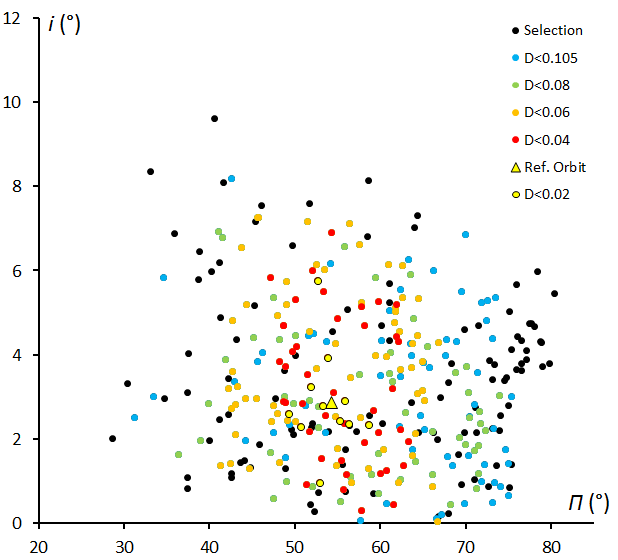
Figure 2 – The plot of inclination i (°) against the length of perihelion П (°) for the 346 preselected orbits. The colors mark the different threshold levels of the D-criteria relative to the parent orbit defined by the median values of the orbits that fulfill the high threshold D-criteria listed in Table 2.
The presence of a cluster of very similar orbits in the dataset should become very obvious in the graph of the inclination i (°) against the length of perihelion П (°) (Figure 2). However a rather dispersed picture emerges with about the same dispersion on the points that represent orbits with low and medium low threshold D-criteria (blue and green dots in Figure 2) as for the orbits that fail for the D-criteria (black dots in Figure 2). Even for the medium high, high and very high threshold values there is no distinct concentration of points visible.
At this point we can conclude that the region is rich in many similar orbits, but these seem to be rather unrelated sporadic orbits. Although the inclination i for all orbits is within 4° ± 4°, the spread in the length of perihelion is too large to conclude anything about the presence of a dust trail in this region. It would be appropriate to end the analyses at this point and to draw conclusions; however we look a bit further at the distribution of these orbits in time.
5 Case study AAQ-927: sporadic orbits?
The announcement of this possible minor shower has been based on very thin evidence, one fireball and three other meteors which appeared to come from the same radiant, while this radiant is situated close to the ecliptic not far from the antapex, a region rich in sporadic dust characterized by very slow velocity meteors. Meteors radiating from near the antapex must catch up with the Earth. The reference orbit given is valid for one single meteor which is not really representative for an entire stream. Altogether, the case of the AAQ-927 could be just spurious, based on a coincidence of few non-related sporadic meteors in the ecliptic region.
The authors (Shiba et al., 2018) mention the term ‘outburst’ although 3 meteors captured in one night and another similar orbit in the next night are rather few events to use the term ‘outburst’. In a private communication Mr. Yasuo Shiba confirms the rich presence of similar but unrelated orbits. The main reason why these four meteors were considered were their physical characteristics, something that is not taken into account in the similarity criteria we use, which are purely geometrics. The four meteors appeared very unusual as ‘melting meteors’, with an unusual high beginning height for such very slow meteors, 10% above the expected beginning height. This is typical for very fresh fragile cometary dust such as for the Andromedids. Perhaps Earth crossed an isolated cloud of such meteoroids in 2017?
Activity profile and periodicity?
If the AAQ-927 are real and not a random coincidence of sporadics, it should have been detected by other networks in previous years, unless perhaps it was a periodic event only detectable in 2017? Only the SonotaCo dataset includes orbits for 2017. Figure 3 represents the proportion of similar orbits that respect the low threshold D-criteria for each year compared to the total number of orbits available for the interval 198° < λʘ < 228°. In total 85731 orbits had been collected during this period. The CAMS network contributed only for 2010, 2011 and 2012 with a large number for 2011 and especially for 2012 (6770 orbits in 2012 for CAMS). No CAMS data was available from 2013 onwards. SonotaCo contributed its smallest number in 2013. A national camera network such as SonotaCo depends a lot on local weather circumstances which can cause large fluctuations on the number of meteors collected from year to year for a given period of time. Figures 3 does not indicate any periodicity for the suspected radiant, the variations are no more than the usual statistical fluctuations.
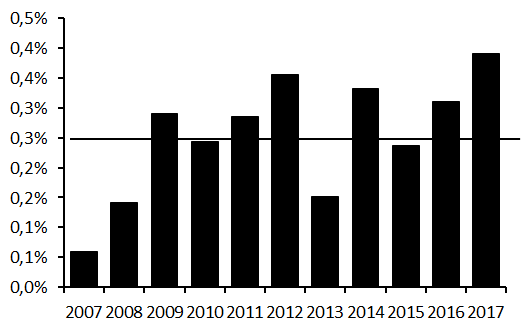
Figure 3 – The percentage of orbits per year that fulfill the low threshold of DD < 0.105 relative to the total number of orbits obtained in the interval of 198° < λʘ < 228°.
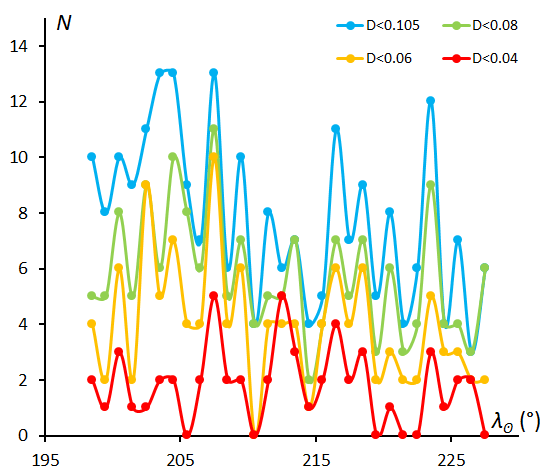
Figure 4 – The number of AAQ-927 look-alike orbits collected per degree of solar longitude λʘ during the period 2006–2017 with blue for DD < 0.105, green for DD < 0.08, orange for DD < 0.06 and red for DD < 0.04.
When we look at the time distribution of all the orbits that fulfill the D-criteria it becomes very obvious that we find these similar orbits at each degree of solar longitude (Figure 4). When extending the investigated period with another 10 days the same distribution is found. There is no trace of anything like a typical meteor shower activity profile with a shower maximum. Figure 4 is a typical distribution for a number of unrelated sporadic look-alike orbits. This is an indication that the alpha Aquariids (AAQ-927) may appear as a result of a random coincidence of few similar sporadic orbits in a period of 2007–2017.
The radiant position, drift and diameter?
With a radiant position at α = 333.7° and δ = +2.2°, valid at λʘ = 212.5° we try to detect a radiant drift. It is obvious that the radiant positions that fulfill the low and medium low threshold criteria display a too large scatter. The medium high and high threshold levels cover a relevant time span and display a weak correlation. We use the high threshold (DD < 0.04) radiant positions to obtain the radiant drift (see Figures 5 and 6). This results in the following radiant drift: Δα = –0.45°/ λʘ and Δδ = +0.1°/ λʘ.
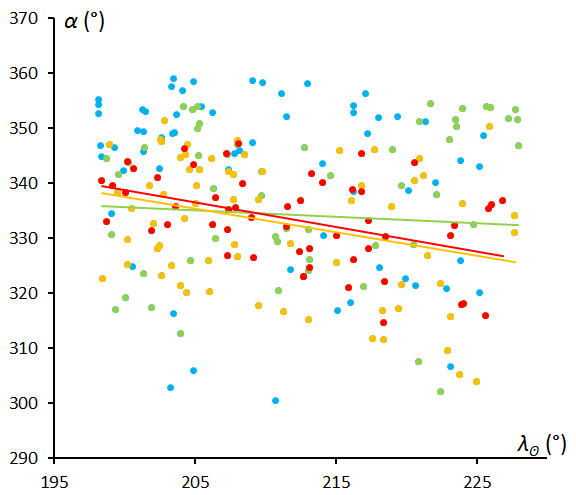
Figure 5 – Radiant drift in Right Ascension α against solar longitude λʘ. The different colors represent the 4 different levels of similarity.
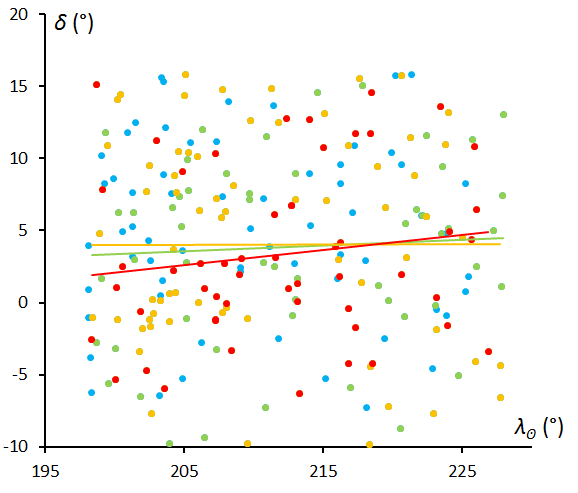
Figure 6 – Radiant drift in declination δ against solar longitude λʘ. The different colors represent the 4 different levels of similarity.
Instead of moving eastwards, the obtained radiant drifts westwards! We take it one step further to the drift corrected radiant positions. The plot of all the uncorrected radiant positions shows a large spread for all levels of threshold on the D-criteria (Figure 7). Such large spread is not unusual for meteor streams with such extreme slow velocity. The radiant drift which we derived proves to have no relevance since all radiant positions get randomly scattered for all threshold levels (Figure 8). A radiant is expected to drift eastwards, drifting westwards makes no sense and is the result of random distributed radiant points that belong to unrelated sporadics.
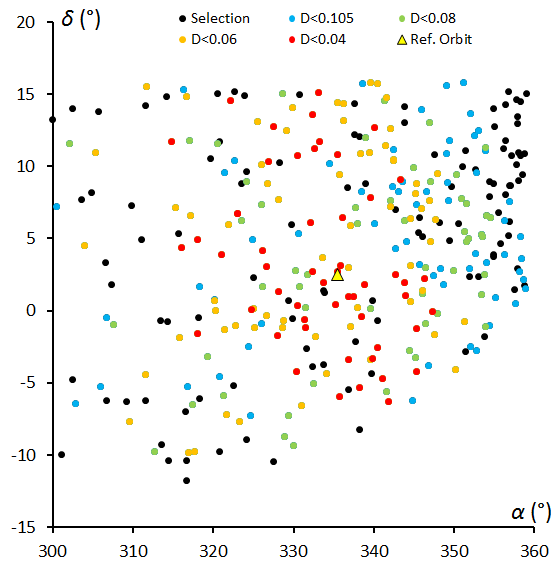
Figure 7 – Plot of the 346 uncorrected radiant positions as selected. The different colors represent the 4 different levels of similarity according to different threshold levels in the D-criteria.
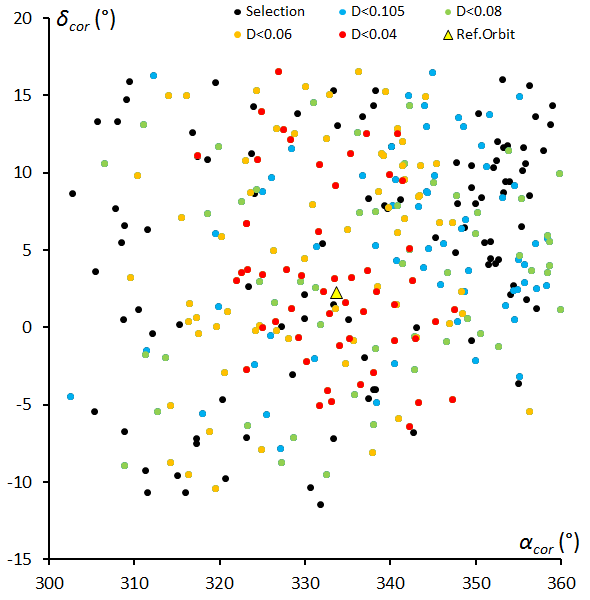
Figure 8 – Plot of the radiant drift corrected radiant positions. The different colors represent the 4 different levels of similarity.
We fail to find any evidence for a shower in past data. To remove all doubts we compute all D-criteria for the 346 orbits of our dataset using the reference orbit of the alpha Aquariids (AAQ-927) given by Yasuo Shiba as parent orbit. The results are given in Table 4.
Although the D-criteria identify a large number of very similar orbits no concentration appears in the graph of the inclination i (°) against the length of perihelion Π (°) with a too large spread in length of perihelion for all threshold levels of D-criteria (Figure 9).
Table 4 – The median values for the selected orbits with four different threshold levels on the D-criteria, using the reference orbit as parent orbit, compared to the reference orbit from literature (Shiba et al., 2018).
| Low | Medium low | Medium high | High | Reference (2018) | |
| λʘ | 210.8° | 210.9° | 211.7° | 211.5° | 213.1° |
| αg | 334.1° | 332.4° | 331.9° | 329.9° | 328.2° |
| δg | 2.8° | 2.4° | 1.1° | 1.0° | +1.8° |
| vg | 8.7 | 8.6° | 8.4 | 8.1 | 8.0 |
| a | 2.18 | 2.17 | 2.17 | 2.16 | 2.16 |
| q | 0.965 | 0.967 | 0.969 | 0.972 | 0.977 |
| e | 0.564 | 0.555 | 0.551 | 0.550 | 0.546 |
| ω | 203.3° | 202.5° | 201.3° | 200.3° | 198.0° |
| Ω | 210.8° | 210.9° | 211.7° | 211.5° | 213.1° |
| i | 2.8° | 2.8° | 2.8° | 2.8° | 2.9° |
| N | 213 | 163 | 108 | 61 | 1 (4) |
| S | 38% | 53% | 69% | 82% |
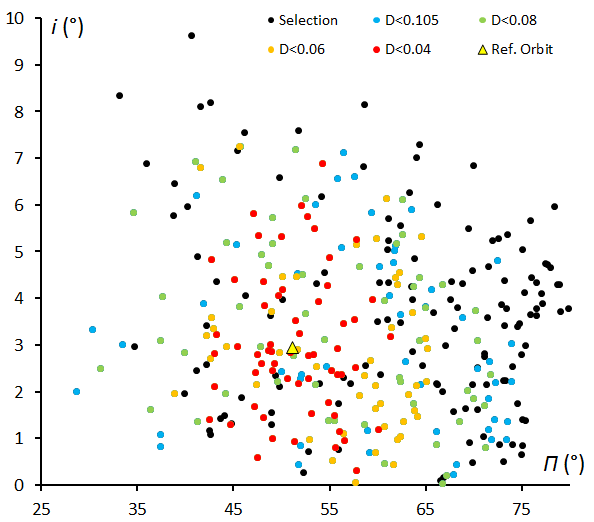
Figure 9 – The plot of inclination i (°) against the length of perihelion П (°) for the 346 preselected orbits. The colors mark the different threshold levels of the D-criteria relative to the parent orbit defined by the orbit published by Shiba et al. (2018).
Other shower characteristics
These slow meteors have a median begin height of 78.8 ± 6.3 km and ending height of 69.0 ± 10.3km, comparing well to the Corvids (COR-63) with 79.1 ± 4.5 as starting height and 71.6 ± 6.5 as ending height (Roggemans, 2017). However the AAQ meteors on which the discovery is based are very different with beginning heights 10% above these values, combined with a very peculiar appearance as “melting meteors”. In a private communication Yasuo Shiba clarified the description in his paper (Shiba et al., 2018): “Alpha Aquariids were identified from data on only four meteors that were not only having analogous radiant positions with similar orbits, but producing similar luminous images stretching back and forth after half of the path. Recorded lengthened trails are not plasma emission left behind on the luminous track which is the so called ‘train’ and not fine pieces peele off from the meteoroid surface which is the so called ‘tail’. But it was estimated that there is light from ablation by many fine, disintegrating meteoroids, occurring at an early stage in the low air density environment. As these ‘dust ball’ meteoroids give the appearance of melting away as they elongate and disintegrate, Mr. Bill Ward named this phenomenon ‘melting meteor’. Melting meteors correlate with high beginning heights generally and agree with the characteristics of the four alpha Aquariid meteors.”
Identification based on peculiar characteristics
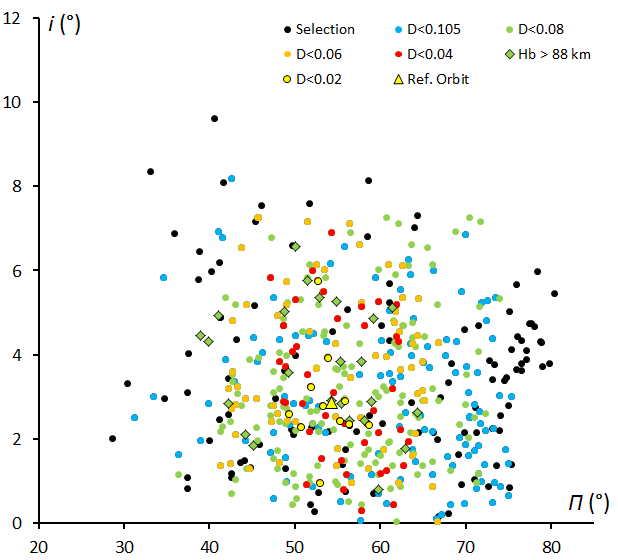
Figure 10 – The plot of inclination i (°) against the length of perihelion П (°) for the 346 preselected orbits. The colors mark the different threshold levels of the D-criteria relative to the parent orbit defined by the median values of the entire dataset corresponding to the results in Table 2. The green diamands represent orbits for meteors ablating 10% or more above the median value for this velocity class.
Looking at the physical aspects, we have no possibility to visualize the appearance of the video recordings of past video observations. These may be very depending on the visualization technics used, and to some extent the look could be an artifact depending on the software to visualize the image. However we can make a query on the beginning height and see if we have AAQ lookalikes with significant above average beginning heights. The result of this selection is shown in Figure 10 for orbits with DD < 0.08 and beginning heights +10% above the median value for beginning heights. Also the candidate AAQ meteors with exceptional high beginning heights (green diamonds) do not show any concentration that could identify a meteor shower. The spread in longitude of perihelion Π is too large.
An isolated meteoroid cloud?
The appearance of these slow meteors may recall the case of the Corvids which were only observed by Cuno Hoffmeister in South West Africa between 1937 June 25 and July 2 with a distinct maximum of 13 Corvids per hour on June 26 (Hoffmeister, 1948). This radiant was at the zenith at the start of the night in Southwest Africa and the numbers of Corvids observed allowed establishing the radiant drift and the activity profile. The appearance of the Corvids in 1937 was of a complete different magnitude than the alpha Aquariids (927) in 2017. Neither before 1937, nor after that year any high activity of these Corvids has been detected, therefore is the 1937 Corvid activity considered having been caused by an isolated meteoroid cloud.
In our time, 80 years later with many video meteor networks active around the globe, it is very unlikely that an event like the Corvids would pass unnoticed. Looking at the time of the meteors on which the discovery of the AAQ (927) is based, the time lapse between the four meteors is rather large which means it was not a very short duration outburst. During the time of the discovery several other video networks were active in the world. The CAMS networks collected as many as 2370 orbits during the two nights concerned, 26 and 27 October. The map with the radiant positions of these many orbits does not indicate anything of an outburst not even some weak activity from the radiant area (Figure 1). If an outburst occurred or even if at least some low activity could have been detected, it should be possibly confirmed by the other active networks. The absence of any hint for alpha Aquariid activity in the 2017 data of other networks requires some skepticism.
Taking into account that this region is rich in similar but unrelated orbits, the very low number of events on which the discovery is based and the absence of an independent confirmation, may indicate the AAQ-927 shower was based on a random coincidence of few lookalike sporadic meteors.
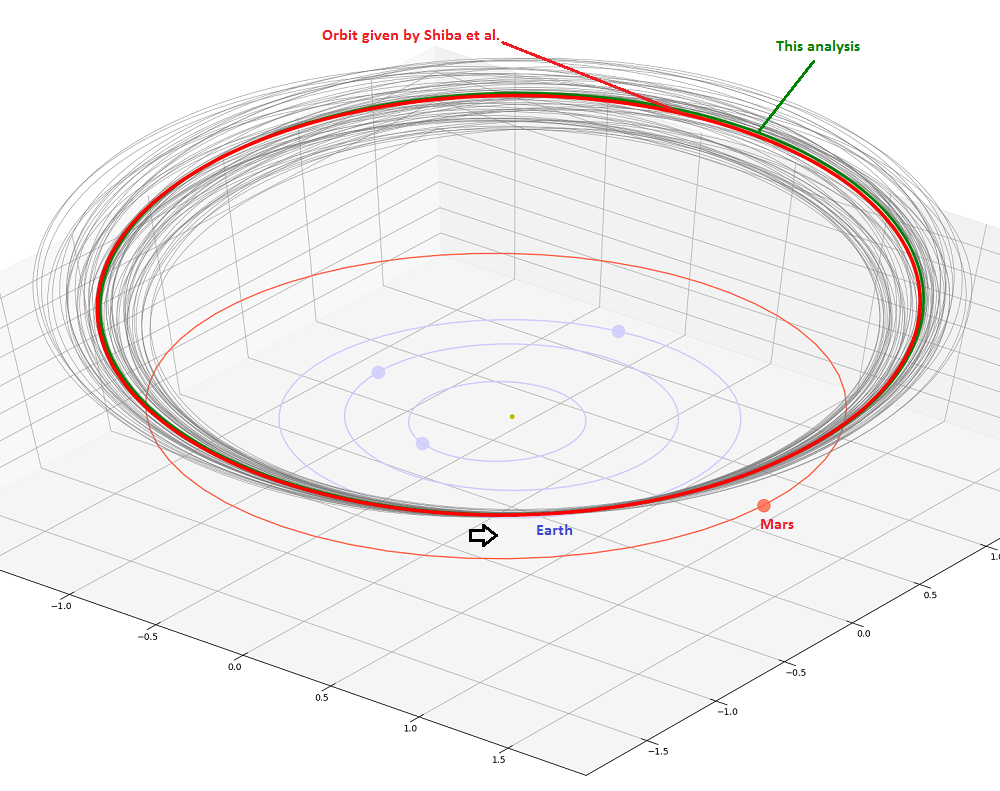
Figure 11 – The orbit of Shiba et al. as listed in the IAU working list of meteor showers (red) and the 61 orbits of our selection that fulfill the high threshold D-criteria with the red orbit as parent orbit. The orbit in green is median of the high threshold orbits. Note how particles on this type of orbits must catch up with the Earth, coming right from behind the Earth on its orbit around the Sun.
6 Conclusion
A search on the orbital data from the major video camera networks worldwide, good for ~686000 orbits (status April 2018), resulted in a collection of very similar orbits with a significant number of orbits that fulfill the high threshold D-criteria of DD < 0.04. However no evidence could be found to prove a dust concentration. The radiant distribution is like a pure random distribution of sporadic orbits. The dispersion of the orbits in time and in space is typical for the rich sporadic dust distribution which produces meteors that radiate from the ecliptic region.
From this analysis we cannot confirm the existence of the alpha Aquariids (AAQ-927) in the orbit data for 2007-2017. Also the candidate orbits with exceptional high beginning heights do not indicate any concentration.
The authors invite other networks to visually browse their results for meteors from this radiant area with exceptional high beginning heights for the nights 25-26-27-28 October 2017. If the Earth travelled through an isolated cloud of fragile meteoroids, other active networks should have recorded members of this AAQ meteor shower. A visual verification of the meteor images checking for the “melting meteor” shape may be the ultimate way to find more evidence for the existence of the recently reported possible new meteor shower. Attention should be paid to the orbit and radiant position, as well as to the beginning height and the visual appearance of these slow meteors.
Acknowledgment
The authors are very grateful to Masahiro Koseki and Yasuo Shiba for their valuable personal communication. Thanks to Jakub Koukal for updating the dataset of EDMOND with the most recent data, to SonotaCo Network (Simultaneously Observed Meteor Data Sets SNM2007-SNM2017), to CAMS (2010-2013) and to all camera operators involved in these camera networks.
References
Drummond J. D. (1981). “A test of comet and meteor shower associations”. Icarus, 45, 545–553.
Hoffmeister C. (1948). “Meteorströme”. Verlag Werden und Wirken Weimar.
Jenniskens P., Gural P. S., Grigsby B., Dynneson L., Koop M. and Holman D. (2011). “CAMS: Cameras for Allsky Meteor Surveillance to validate minor meteor showers”. Icarus, 216, 40–61.
Jopek T. J. (1993). “Remarks on the meteor orbital similarity D-criterion”. Icarus, 106, 603–607.
Kornoš L., Matlovič P., Rudawska R., Tóth J., Hajduková M. Jr., Koukal J., and Piffl R. (2014). “Confirmation and characterization of IAU temporary meteor showers in EDMOND database”. In Jopek T. J., Rietmeijer F. J. M., Watanabe J., Williams I. P., editors, Proceedings of the Meteoroids 2013 Conference, Poznań, Poland, Aug. 26-30, 2013. A.M. University, pages 225–233.
Roggemans P. (2017). “Variation in heights of CAMS meteor trajectories”. eMN, 2, 80–86.
Roggemans P. and Johannink C. (2018). “A search for December alpha Bootids (497)”. eMN, 3, 64–72.
Shiba Y., Shimoda C., Maeda K., SonotaCo, Sekiguchi T., Yoneguchi K., Kawakami H., Miyoshi T., Yamakawa H., Okamoto S., Muroishi H., Masuzawa T., Kamimura T. (2018). “A new meteor shower Alpha Aquariids(#927:AAQ)”. WGN, Journal of the International Meteor Organization, 46, 79–81.
SonotaCo (2009). “A meteor shower catalog based on video observations in 2007-2008”. WGN, Journal of the International Meteor Organization, 37, 55–62.
Southworth R. R. and Hawkins G. S. (1963). “Statistics of meteor streams”. Smithson. Contrib. Astrophys., 7, 261–286.





